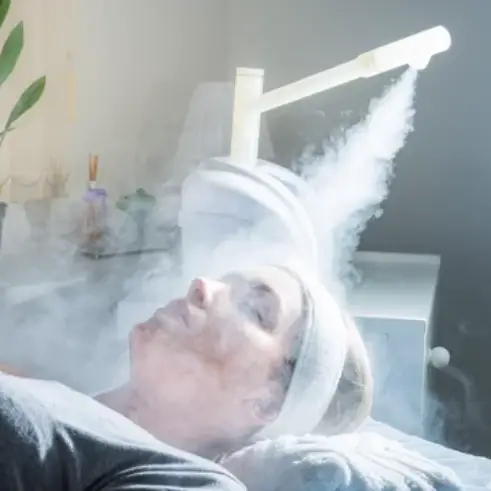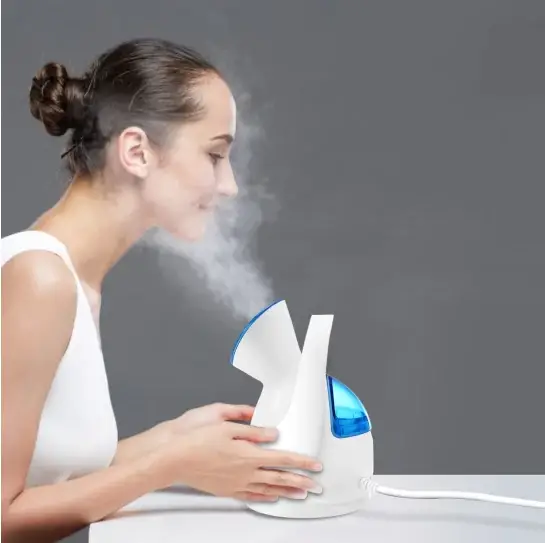Facial steaming is all the rage in skincare these days, getting tons of buzz for its supposed perks. Basically, it’s like treating your face to a mini steam bath to freshen up and give your skin a boost. But hey, even though there are plenty of good things about it, it’s super important to figure out how often you should do it to keep your skin happy and healthy.
This article is here to help you navigate the world of facial steaming and understand how often you should do it for the best results. We’ll take a deep dive into the ins and outs of facial steaming, providing you with easy-to-follow steps for safe and effective practice.
We’ll also explore the various advantages and disadvantages of steaming your face frequently, giving you a well-rounded understanding of this skincare technique.
Busy? Save this pin for later.
The Science Behind Facial Steaming
Facial Steaming Process
Facial steaming involves the application of hot steam to the face, aiming to cleanse and rejuvenate the skin. The heat from the steam helps to open up the pores, facilitating deep cleansing and removal of impurities.
Improved Blood Circulation
Facial steaming is closely linked to improved blood circulation, which plays a vital role in maintaining a healthy complexion. The temporary increase in blood flow during steaming can contribute to a radiant glow, enhancing the skin’s overall appearance.
Enhanced Hydration
Through facial steaming, the skin’s ability to absorb moisturizing ingredients is significantly improved. This process enhances skin hydration, promoting a healthier and more supple complexion.
Renowned dermatologists and estheticians support these key points, emphasizing the positive impact of facial steaming on skin health and appearance.
You Might Also Like: 8 Budget-Friendly Skincare Must-Haves for Every Skin Type
Step-by-step Instructions for Safe and Effective Facial Steaming
To get the best results from facial steaming, it’s important to follow the right steps. Here’s a detailed guide on how to do safe and beneficial facial steaming:
1. Use Distilled Water
Using distilled water in your facial steamer is essential to prevent mineral buildup in the device and on your skin. Tap water often contains minerals that can accumulate in the steamer over time, leading to potential blockages and reduced efficacy.
using distilled water, can maintain the optimal functioning of the steamer while preventing any unwanted residue from being deposited onto your skin during the steaming process.
2. Limit Steaming Time
It’s important to limit your facial steaming session to no more than 10 minutes. Prolonged exposure to steam can lead to overexposure, causing potential adverse effects such as excessive dryness or sensitivity. By adhering to a shorter duration, you can effectively open up your pores without subjecting your skin to unnecessary risks.
3. Post-Steaming Skincare Routine
After completing your facial steaming session, follow up with a gentle cleanser to remove any loosened impurities from the surface of your skin. This step is crucial in ensuring that the deep-cleansing benefits of the steam are maximized.
Following cleansing, apply a moisturizer to lock in the hydration and benefits derived from the steam. This post-steaming routine helps maintain the improved skin hydration and cleanliness achieved through the steaming process.
Proper technique is key in reaping the rewards of facial steaming without exposing your skin to unnecessary risks or adverse effects.
Pros and Cons of Frequent Facial Steaming
Facial steaming, when done in moderation, can offer various benefits to the skin. However, excessive steaming can lead to adverse effects. It’s essential to understand both the advantages and drawbacks to determine the ideal frequency for your skincare routine.
Advantages of Regular but Moderate Steaming Sessions
- Adding facial steaming into a weekly skincare routine can lead to improved product efficacy. The heat from the steam helps open up the pores, allowing for better absorption of skincare products, leading to enhanced results.
- Additionally, regular facial steaming can contribute to relaxation and stress relief, promoting a sense of well-being. The warm steam can provide a soothing experience, making it an enjoyable addition to a self-care regimen.
Possible Risks Associated with Excessive Steaming
- On the other hand, excessive facial steaming can lead to adverse effects on the skin. Oversteaming may result in excessive dryness as it strips the skin of natural oils, leading to dehydration and potential irritation.
- Moreover, frequent exposure to steam can make the skin more sensitive over time, potentially exacerbating existing skin conditions or causing new ones to develop.
It’s important to find a balance and not overdo facial steaming in your skincare routine. Enjoy the benefits of better product absorption and relaxation while being aware of the risks of doing it too much.
Determining Your Ideal Steaming Schedule
When it comes to steaming your face, there’s no one-size-fits-all rule. Your ideal steaming routine depends on your skin type and sensitivity. Here are some tips to help you figure out how often to steam:
General Recommendations for Different Skin Types:
- Oily Skin: If you have oily skin, you may benefit from more frequent facial steaming sessions. Aim to steam your face once or twice a week to help regulate sebum production and unclog pores.
- Dry Skin: On the other hand, if you have dry skin, it’s important to be cautious with facial steaming as it can potentially strip away natural oils. Limit your steaming sessions to once every two weeks to avoid excessive dryness.
- Combination Skin: For those with combination skin, a balanced approach is key. Consider steaming your face once a week, focusing on the areas that tend to be oilier, such as the T-zone.
Adapting the Steaming Routine for Sensitive Skin:
If you have sensitive or reactive skin that is prone to irritation, it’s crucial to take extra precautions when incorporating facial steaming into your skincare routine. Here are some gentle alternatives and considerations:
- Reduce Frequency: Steaming once every two weeks or even once a month may be more suitable for sensitive skin types. This allows your skin to recover and minimizes the risk of overstimulation.
- Lower Temperature: Opt for lukewarm steam rather than hot steam. This helps prevent excessive dilation of blood vessels and reduces the likelihood of redness or flushing.
- Shorter Duration: Keep your steaming sessions brief, around 5 minutes, to minimize potential irritation.
- Patch Test New Products: If you plan on using any additional products during or after steaming, ensure that they are suitable for sensitive skin by conducting a patch test beforehand.
Keep in mind, these are basic suggestions. Pay attention to how your skin reacts and change how often you steam accordingly. If you see irritation or your skin gets worse, it might mean you need to steam less often or with less intensity.
Listening to Your Skin: Signs to Adjust Your Steaming Frequency
Each person’s skin possesses its own distinct characteristics, rendering what proves efficacious for one individual potentially ineffectual for another. By attentively discerning your skin’s demands and deciphering the signals it manifests, you can ascertain whether your steaming regimen leans towards excess or deficiency.
Signs That You May Be Steaming Too Often or Not Enough:
- Increased breakouts: If you notice a sudden increase in breakouts or acne after incorporating facial steaming into your routine, it may be a sign that you are over-steaming. Steaming too frequently can overstimulate the sebaceous glands, leading to an excess production of sebum. This can clog pores and result in breakouts.
- Lack of improvement in texture: Facial steaming is known for its ability to improve skin texture by promoting exfoliation and removing dead skin cells. However, if you have been steaming regularly but haven’t seen any improvement in the texture of your skin, it could indicate that you are not steaming enough. In this case, increasing the frequency of your sessions may be beneficial.
The Importance of Regular Skin Assessments:
Regularly assessing your skin’s condition is crucial for determining whether your current steaming routine is suitable for you. Here are a few tips to help you evaluate your skin effectively:
- Observe changes in oiliness: If your skin becomes excessively oily after steaming, it might be a sign that you are steaming too often. On the other hand, if your skin feels tight and dry even after moisturizing, it could indicate that you need to steam more frequently.
- Pay attention to sensitivity: If you experience increased redness, irritation, or sensitivity after steaming, it’s essential to adjust your steaming frequency. Those with sensitive or reactive skin may need to reduce the frequency or duration of their sessions to avoid exacerbating these issues.
Expert Tips for Safe and Effective Facial Steaming
When it comes to facial steaming, ensuring safety and practicing best hygiene practices are essential for reaping its full benefits. Here are some expert tips to consider:
1. Preparation: Cleansing the Skin Thoroughly Before Steaming
It’s crucial to start with a clean face before beginning the steaming process. This step helps prevent dirt, makeup residue, and bacteria from being trapped in the pores during steaming. Cleansing the skin thoroughly ensures that the steam can effectively open up the pores and facilitate deep cleansing without any obstructions.
2. Maintaining Hygiene: Using Filtered Water and Cleaning the Steamer Device Regularly
It’s best to use distilled or filtered water when making steam for facial steaming. This prevents impurities from tap water that can harm the skin. Also, remember to clean your facial steamer regularly to keep it free from mineral buildup and ensure clean steam.
By following these helpful tips for safe and effective facial steaming, you can get the most out of this skincare practice while reducing any risks related to poor hygiene and preparation.
These practices not only contribute to a more enjoyable and effective facial steaming experience but also support overall skin health by promoting cleanliness and preventing exposure to harmful substances.
Personal Experiences with Facial Steaming: A Fine Balance
- Finding the right balance is crucial; excessive steaming can lead to dryness or sensitivity, while infrequent sessions may not yield the desired benefits.
- Experimenting with different frequencies and observing how my skin responds has been key in determining the optimal steaming schedule.
- Moderation and mindfulness have allowed me to enjoy the benefits of facial steaming without compromising the health of my skin.
- It’s essential for individuals to personalize their steaming routine based on their skin’s unique needs and sensitivities.
Recommendations for Suitable Types of Steamers or Equipment
When it comes to facial steaming, choosing the right equipment is crucial to ensure a safe and effective experience. Here are some recommendations for suitable types of steamers or equipment:
1. Facial Steamer
A dedicated facial steamer is designed specifically for steaming the face and offers several advantages. Look for a steamer with the following features:
- Adjustable steam settings: This allows you to control the intensity of the steam based on your skin’s needs.
- Timer: A built-in timer ensures that you do not exceed the recommended steaming time.
- Safety features: Opt for a steamer with an automatic shut-off function to prevent overheating.
- Fine mist: Look for a steamer that produces a fine mist of steam, as this ensures even distribution on the face.
2. Warm Towel Method
If you do not own a facial steamer, you can still enjoy the benefits of facial steaming using the warm towel method. Here’s how to do it:
- Start by cleansing your face thoroughly using a gentle cleanser.
- Soak a clean towel in hot water and wring out the excess moisture.
- Place the warm towel on your face and leave it on for a few minutes until it cools down.
- Gently remove the towel and proceed with your skincare routine.
3. DIY Steam Bath
Another option is to create a DIY steam bath at home using readily available ingredients. Here’s how you can do it:
- Boil water in a large pot or kettle and transfer it to a heat-resistant bowl.
- Add herbs or essential oils of your choice, such as chamomile or lavender, to enhance the steam’s soothing properties.
- Position your face over the bowl, ensuring a comfortable distance to avoid any burns, and drape a towel over your head to trap the steam.
- Steam your face for 5-10 minutes, taking breaks if needed.
Remember, regardless of the method or equipment you choose, follow these additional tips to ensure a safe and effective facial steaming session:
- Use distilled water: Using distilled water in your steamer or DIY steam bath helps prevent mineral buildup on the skin and in the equipment.
- Cleanse before steaming: Always start with a clean face to avoid trapping dirt and bacteria in your pores during the steaming process.
- Limit steaming time: It’s important not to overexpose your skin to steam. Limit your steaming session to no more than 10 minutes to avoid excessive moisture loss.
- Moisturize after steaming: After steaming, apply a hydrating moisturizer to lock in the benefits of the steam and keep your skin nourished.
Experiment with different methods and find what works best for your skin type and concerns. Remember, moderation is key when it comes to incorporating facial steaming into your skincare routine.
You Might Also Like: 5 Beauty Secrets for Glowing Skin
Potential Alternative Skincare Practices for Those Unable to Steam Their Face
While facial steaming offers numerous benefits for the skin, it may not be suitable for everyone. Some individuals may have certain skin conditions or personal circumstances that prevent them from safely enjoying the benefits of facial steaming.
However, there are alternative skincare practices that can provide similar results and help maintain a healthy complexion. Here are some potential alternatives:
Warm Compress:
A warm compress is a simple yet effective way to open up the pores and cleanse the skin without the need for a steam facial. You can achieve this by soaking a clean washcloth in warm water and gently pressing it onto your face for a few minutes. The warmth will help loosen dirt and debris, allowing for easier removal and promoting a clearer complexion.
Face Mask:
Incorporating a face mask into your skincare routine is another excellent alternative to facial steaming. Different types of masks, such as clay masks or sheet masks, can provide deep cleansing, hydration, and nourishment to the skin. Look for masks that target specific skincare concerns like acne, dryness, or dullness.
Facial Scrub:
Exfoliating the skin regularly is crucial for removing dead skin cells and promoting a brighter complexion. Using a gentle facial scrub can effectively achieve this without the need for steaming. Look for scrubs with mild exfoliating particles or chemical exfoliants like alpha-hydroxy acids (AHAs) or beta-hydroxy acids (BHAs) to suit your skin type.
Hydration Mist:
A hydrating mist can help replenish moisture levels in the skin while also providing a refreshing sensation. Look for mists containing ingredients like hyaluronic acid or rosewater to hydrate and soothe the skin throughout the day.
Hot Towel Method:
Similar to the warm compress technique, the hot towel method involves using a towel soaked in warm water to create a steam-like effect. Place the warm towel over your face for a few minutes, allowing the heat to open up the pores and enhance product absorption. Follow up with your regular skincare routine to lock in the benefits.
If you have sensitive or reactive skin, always perform a patch test before trying any new skincare practice to avoid potential irritation or adverse reactions.
Final Thoughts
To make the most of facial steaming, it’s important to know what your skin needs and treat it accordingly. Here are some key takeaways:
Understand Your Skin: Every person’s skin is different, so take the time to learn about your specific skin type and concerns. This will help you determine how often you should steam your face and what temperature and duration are best for you.
Respect Your Skin’s Limits: While facial steaming can be beneficial, overdoing it can lead to irritation and dryness. Always listen to your skin and adjust your steaming routine accordingly.
Be Mindful of Existing Conditions: If you have sensitive skin, rosacea, or other skin conditions, consult with a dermatologist before incorporating facial steaming into your skincare routine. They can provide personalized advice and recommendations.
Prep Your Skin Properly: Before steaming, cleanse your face thoroughly to remove any makeup, dirt, or impurities. This will ensure that the steam can penetrate effectively and provide maximum benefits.
Follow Up with Skincare: After steaming, apply a hydrating serum or moisturizer to lock in moisture and nourish your skin. This step is crucial as it helps prevent dehydration and maintains the benefits of steaming.
Stay Consistent: Like any skincare routine, consistency is key when it comes to facial steaming. Incorporate it into your weekly or monthly self-care ritual and make adjustments based on how your skin responds.
FAQs (Frequently Asked Questions)
What are the benefits of facial steaming?
Facial steaming offers numerous benefits, including deep cleansing and removal of impurities, improved blood circulation, enhanced skin hydration, and improved product efficacy and relaxation.
What are the potential risks associated with excessive facial steaming?
Excessive facial steaming can lead to negative effects such as excessive dryness or sensitivity. It’s important to practice moderation when incorporating facial steaming into a skincare routine.
How can I determine the ideal frequency for facial steaming based on my skin type?
You can follow general recommendations for different skin types, which suggest a recommended frequency range for oily, dry, and combination skin. Additionally, individuals with sensitive skin should consider special considerations and gentle alternatives to avoid irritation.
What are the signs that indicate I may be steaming my face too often or not enough?
Signs that you may be steaming too often or not enough include increased breakouts or lack of improvement in texture. It’s important to regularly evaluate your skin’s condition and adjust your steaming routine accordingly for optimal results.
What are some expert tips for safe and effective facial steaming?
Some expert tips for safe and effective facial steaming include starting with a clean face to prevent dirt and bacteria from being trapped in the pores, using filtered water to avoid exposing the skin to impurities in the steam, and cleaning the facial steamer device regularly to maintain hygiene.
How can I find a balance that works for my skin when incorporating facial steaming into my skincare routine?
Finding a balance that works for your skin when incorporating facial steaming involves experimentation and paying attention to how your skin responds to steaming sessions. It’s important to listen to your skin’s needs and make adjustments as necessary for optimal results in the long run.
You Might Also Like: 4 Foods That Can Help Smooth Out Forehead Lines Naturally







Leave a Reply
You must be logged in to post a comment.